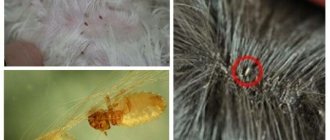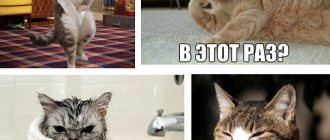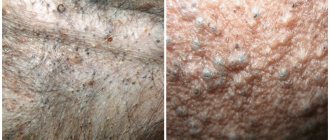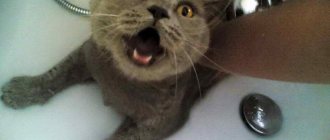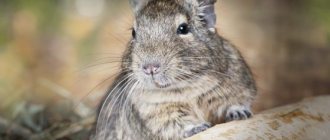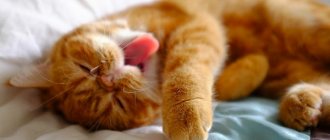When someone adopts a kitten, they expect that the little cat will grow into a large and beautiful four-legged friend with silky hair. But in order for an animal to grow and develop properly, it needs to be properly cared for. Sometimes cats and kittens develop mats on their fur. It is impossible to ignore this, and sometimes it is even dangerous.
- 2 Why mats are dangerous
- 3 How to comb a cat's mats
3.1 Classic combing and cutting
3.1.1 Video: how Persian cats are cut in salons
- 4.1 Photo gallery: types of combs for grooming cats
What are mats?
The fur of cats, especially long-haired breeds, requires careful care. With a lack of hygiene, poor nutrition and other mistakes when keeping pets, their fur begins to deteriorate. This affects not only appearance, but also health.
Older pets cannot provide themselves with the same careful care as younger pets. The wool begins to get tangled, matted, and tangles form. However, young age is not a guarantee that lumps will not appear.
Reasons for the formation of tangles
TO
Cat tints, or scientifically called trichomes, appear mainly in long-haired breeds. This pathological condition of the coat is characterized by the formation of matted and tangled hairs. The lump of resulting wool is so dense that it resembles thick felt fabric from the outside.
In the vast majority of cases, trichomes appear in an animal in a place that is difficult for it to reach. In these places, wool is most susceptible to mechanical friction. The location of the mats is the stomach, groin area, under the tail, on the inside of the front and hind legs, in the back and neck.
Veterinary experts associate the appearance of trichomes in long-haired cats with improper care of the cat by the owner.
In some cases, the cause of tangles is a pathological focus on the skin - a wound or ulcers, with the constant release of exudate, which provokes sticking and further matting of the hair.
In addition to the factors described above, there are a number of other reasons that can lead to the appearance of trichomes. The main ones are:
- dirty coat – dust and wet dirt cause hairs to attract and stick together;
- Stressful conditions in a cat on an ongoing basis;
- disruption of the endocrine system (hormonal imbalances leading to an imbalance in the metabolism of the skin);
- disruption of metabolic processes in the body;
- parasitic infestations - fleas, ticks and various lice-eaters;
- age of the animal - old and weakened animals cannot care for themselves properly;
- violations in the diet (acute deficiency of essential nutrients, vitamins and minerals, disrupts the general condition of the skin and coat);
- improper care of your pet’s fur (especially noticeable in breeds with long hair, since the coat is constantly changing, it needs to be combed and untangled small matted lumps, preventing the appearance of large tangles);
- excessive or irregular bathing of the cat - it is necessary to bathe the animal as needed, and after taking water procedures, it is important to properly dry and comb the fur, which will make it possible to avoid the formation of trichomes.
It is important to understand that tangles formed from wool are not only unsightly, but also indicate problems in the care or condition of the animal’s body. Disruption of metabolic processes, as well as damage to the skin by parasites or sores, also provokes the development of tangles.
It follows from this that the appearance of trichomes is a kind of signal from the body about problems in feeding or care. Due to the uncomfortable sensations that appear with tangles, the cat becomes irritated, tries to gnaw out the matted fur, tears it with its paws and can injure the delicate skin.
Against the background of damage, bacterial pathogenic microflora may appear, complicating the condition of the animal’s body.
Causes
If pets are healthy and can take care of their hygiene, they usually do not develop tangles. However, there are cat breeds with fluffy fur and thick undercoat that are prone to ball formation. These include Persians, British, Turkish Angora and others.
Not all long-haired breeds suffer from mats. For example, Siberian cats and Maine Coons rarely develop lumps. Mainly in places of thick and wavy undercoat (on the “collar”, “pants”).
Mats on wool appear for the following reasons:
- the pet is rarely or not brushed at all;
- during the molting period, the animal’s old fur is not combed out;
- the pet is sick;
- the cat is washed with an incorrectly selected shampoo; when soaping, the fur becomes very crumpled, which is why dense clumps are formed;
- the cat is lazy and fat, obese;
- the pet does not eat rationally, which is why it may develop vitamin deficiency (the fur becomes very loose and the risk of lumps forming increases);
- sticky substances (for example, jam, honey, paint, etc.) have come into contact with the fur;
- pathological conditions develop: oncology, parasites, dermatitis, endocrine disorders.
If a pet develops tangles, the owner is to blame. This means he did not take good care of the animal.
Why does a cat have mats?
When breeding long-haired breeds, the emphasis was placed on the properties of the coat. Cats with particularly thick and long fur were selected for breeding. Animals are sometimes unable to take care of such “fur coats” using only their paws and tongue. Therefore, there are often cases when, due to lack of care for long-haired felines, the hair becomes matted and forms tangles. Cutting out the formed lumps is not a problem, but it is better not to bring the animal to such a state.
What usually causes mats in cats:
- poor quality nutrition with a lack of vitamins and minerals;
- the presence of dandruff, which thickens the tangles and makes it impossible to comb the hair;
- using inappropriate cleaning products when bathing, such as using shampoos intended for humans;
- improper soaping during bathing and drying after it;
- fur contamination that the cat cannot cope with on its own (grease, chemicals, etc.);
- diseases: the fur first reacts to the animal’s poor health;
- parasitosis.
The hairline is renewed cyclically. Some hair falls out every day, and new ones grow in their place. If the fallen hairs are not removed in time, a hairball will form, that is, a tangle. It can form anywhere, but most often it appears behind the ears, on the tail, on the neck, in the groin or armpits. Even short-haired cats are susceptible to matting, although this does not happen often. Usually this situation is preceded by poor health or severe soiling of the coat.
Why are they dangerous?
The appearance of matted fur spoils the appearance of the animal. This is a huge disadvantage for a breeder of purebred cats. In addition, petting a pet with mats is unpleasant.
However, these are not the worst consequences. Mats can provoke the development of various diseases. Pathogenic microorganisms begin to multiply in matted wool. When a pet licks itself, they enter the body and continue their synthesis there.
Fleas, lice, ticks and other parasites take root well in tangles. The skin under the lumps becomes rotten, dermatological problems arise that are difficult to treat. In addition, the cat will try to independently remove matted fur with its claws, and in the process may cause wounds to itself. Such damage will take a long time to heal.
Danger of tangles
For a cat, the appearance of mats causes not only discomfort. Dense lumps pull on healthy hairs that accidentally get there. When moving, the cat feels pain. Sometimes quite strong. Trying to get rid of lumps, he may even injure himself with his claws or teeth. Such wounds then heal for a very long time. Other dangers of hairballs :
- The appearance of mats is not just an unaesthetic appearance of a cat. Lumps can cause a number of diseases.
- Cats try to lick mats. As a result, matted lumps become wet from saliva. This is a good environment for various parasites and microbes to appear and multiply.
- Under the furball, the animal's skin begins to swell very much. As a result, dermatological diseases also appear.
- Another reason why you need to get rid of tangles faster is accidental injury to the animal. This can happen during play if the lump gets caught on objects or furniture. The cat will try to get rid of the obstacle and will begin to escape. This could result in serious injury.
This may be further associated with pain and fear. Then the cat will begin to resist if the owner tries to remove the matted hairballs. If you don’t get rid of tangles, then every day there will be more and more of them. As a result, strong moisture will begin to accumulate under the fur, and this is fraught with the appearance of ulcers and inflammation.
Removal methods
Tangles are removed from wool in the following ways:
- If the lumps are small, you can comb them out. The pet should be placed on its side and stroked. This is necessary so that he calms down and does not break out. First, comb the sides and back, neck and chest, forelimbs, tail. It is more difficult to get rid of tangles on the stomach and hind legs. Most likely the animal will bite.
- Large clumps are recommended to be cut lengthwise and then combed.
- If there are a lot of tangles, it is completely impossible to comb them out, then the tangled hair will have to be cut to the ground. You need to be very careful: a cat’s skin is thin and can be easily damaged. Clumps can be removed with scissors, people clippers or hair clippers. The receding hairline will heal after a few months.
- At the pet store you can purchase a special device called a tangle cutter. This is a comb with blunt ends, blades between the teeth.
- You can take your cat to a veterinarian or pet groomer. There your pet will be trimmed at an affordable cost.
- To deal with long unnecessary hair, there is a special comb - a furminator. Not only will it help get rid of clumps, but it will also be an indispensable tool for daily combing.
Self-removal
You can eliminate cat tangles yourself at home if the situation is not advanced. An inexperienced owner is advised not to deal with tangles, but to entrust the procedure to a professional. A frightened cat often breaks out, but may not be able to do so.
The procedure must be performed with extreme care. Lumps that have formed close to the skin, even when slightly pulled away, cause intense pain.
You can trim the tangles with nail scissors or a hair clipper. Small and loose hairballs can be easily untangled using a comb and special veterinary products to make combing easier. A dense ball of wool will have to be broken up with a tangle cutter.
How to use a cat hair cutter
A modern and popular device for breaking hairballs in long-haired pets is called a mat cutter.
Externally, the tangle cutter resembles a comb, but is equipped not with teeth, but with thin steel blades (4-12 pieces). The tool is completely safe for animals. When choosing a product, it is necessary to take into account the breed characteristics of the coat: the longer the hair, the longer the blade should be.
The quality of a mat cutter for cats is determined by the following parameters:
- the number of blades (for breeds prone to forming lumps, you should choose a hair cutter with the maximum number of sharp teeth);
- the length of the blades (in advanced cases, when large trichomes appear, you will have to purchase a product with long teeth);
- material (a high-quality webbing cutter is equipped with blades made of high-strength steel);
- comfort of the handle (the shape should be optimal for gripping and holding, the surface should be rubber to prevent slipping).
For a cat with large trichomes, a vertical mat cutter is suitable. To combat regularly appearing small lumps, a horizontal product resembling a vegetable peeler is convenient. In a horizontal device, the rounded blades are directed parallel to the handle; they are safe to use, since they are sharp on one edge and blunt on the opposite.
It is difficult to remove trichomes that have formed in hard-to-reach areas: near the ears, in the groin and axillary area, on the paws with a horizontal and vertical wedge cutter. A teardrop-shaped product is required, characterized by its small size and rounded shape, equipped with a single blade.
It is important to use the purchased tangle cutter correctly without causing harm to the cat. Basic rules for using the product:
- Before the procedure, calm the cat, treat it with a treat, and caress it.
- To be on the safe side, ask a household member to hold your pet while removing lumps.
- Comb out clumps in the direction of hair growth.
- Do not press the blades on the skin, try not to cause injury.
- To make it easier to comb out dense lumps that have formed, use a softening spray available at a veterinary store.
A chain cutter is a tool used as a last resort. It is unacceptable to use the product regularly: it can seriously damage your cat’s coat. Therefore, it is advisable to prevent the appearance of tangles.
Combing tangles
You should not rush to grab the mat cutter; you should try to comb out the mat. If the lump is small and loose, it is not difficult to rid your pet’s fur of excess weight. For the procedure, it is necessary to use not a human, but a special comb for animals.
- Wait for the cat to be in a calm and peaceful mood.
- Place the animal on the pad, being careful not to scare it. The mat must be visible.
- Pet the cat and talk kindly.
- Place your palm on the tangle, and with your fingers firmly grasp the tangled strand at the base so that the animal does not experience pain during the procedure.
- Using smooth, leisurely, short movements, move the comb over the tangle, gradually breaking it into several parts.
- Comb each part in the same way.
- Finish with a standard combing.
To easily remove large mats from a cat, you can use veterinary hair softeners - powder or spray.
Cutting out tangles
Trimming is the easiest way to get rid of large mats from a cat. But you should not rush to cut off the tangles, especially if the cat is a show cat. There is a high probability that the hair will change after shearing; the grown hairs will have a different shade or structure. Therefore, before cutting, you should try to comb out the tangles.
A cat's mats should not be cut off completely, but cut lengthwise with nail scissors. You should act carefully, trying not to injure your pet's skin. A lump divided in half is easier to comb out. It is unacceptable to cut it out completely: there will be a bald spot.
Rules for removing mats in cats
Recommendations for removing mats:
- The process of eliminating lumps is long. Most likely, your pet will not like it. The pet will not give in and will start fighting. Therefore, it is better to comb out tangles together: one person holds the cat, the other combs it. If the animal is very nervous, then it is better not to traumatize its psyche and get rid of the matted fur not at once, but several times.
- Only areas with long hair are clipped. It is better not to touch the paws and head. It's okay if your pet looks like a lion. The fur will grow back in a couple of months.
- Until the mats are removed, washing the animal is prohibited. After water, lumps are more difficult to comb out.
- After combing, treat the pet's fur with an antistatic spray. The product will detangle your hair and prevent further formation of tangles.
Preventing problems with your cat's coat
Preventive measures for any fluffy long-haired cats, in particular Maine Coons, Siberians, Angoras and Persians, include the following simple rules:
- Brush the animal at least once a week (Persians are scratched more often, sometimes every day).
- To untangle the hair knot, use a special spray.
- When combing your cat's coat, use a comb with round toothed ends so as not to injure the cat.
- When shedding, be sure to remove loose hair using a slicker. At other times, this tool should not be used.
- In extreme heat at the dacha or at home, a very “shaggy” cat should be trimmed. This will not only prevent tangles, but also protect it from overheating and heat stroke.
- Sometimes, to stop the formation of mats, you need to change the cat's food or add a little more fats and vitamins.
A good owner monitors the health of his pet and its appearance. Small fur seals need to be eliminated immediately, then there will be no need for labor-intensive removal of tangles. Simple brushing takes no more than five minutes a day, brings a lot of pleasure to the animal when done correctly and protects it from painful formations in its luxurious fluffy fur.
Preventive measures
The formation of lumps is easier to prevent than to deal with them later. You need to set aside time every day to care for your pet. It is recommended to brush the animal regularly.
Your pet should be accustomed to brushing when he is still a small kitten. The pet will get used to it and in adulthood there will be no problems with combing.
You cannot use a regular “human” comb on a cat. A personal toiletry item is selected for the pet based on the type and length of fur.
For young animals and kittens, it is recommended to purchase a brush. It is better to buy with artificial bristles that have an antistatic effect.
After washing, until the pet is dry, a massage mitten takes good care of the fur. But it is not able to completely replace a comb.
A cat comb is perfect for daily brushing. It has rounded ends and will not cause pain to your pet. Available in any length and width. When combing with a comb, you can find fleas if they are infested.
For very fluffy pets, a slicker is used (for example, for the British breed). It looks like a brush, but instead of bristles it has small metal teeth with curved ends. It is only suitable for preventing mats in cats with healthy fur.
A furminator (comb-trimmer) is used to comb out the undercoat. Such a gadget costs a lot, but it helps save time on caring for your pet. The device comes in various types: for kittens, long-haired, short-haired breeds.
The pet must be taken to the veterinary clinic periodically for examination. This will help not only to promptly detect the formation of lumps, but also to prevent various pathological conditions. Also, a cat with long hair (for example, a Persian) needs to be cut before the summer season.
How to remove mats from a cat at home
The owner can tidy up the pet's fur on his own. To remove a small amount of tangles you will need:
- product for home or professional cat hair care;
- comb with sparse and non-sharp teeth;
- tangle cutter (there are different types);
- a brush or a special glove for combing.
Particular attention should be paid to the choice of products that make it easier to comb the coat. They must be hypoallergenic, suitable for a certain type of wool, and have a high-quality composition. For example, the Elite spray conditioner from the Elite Professional series with allantoin, glycerin and a complex of conditioning components is suitable. It is adapted for home use, has an antistatic effect to reduce electricity, a softening and moisturizing effect, adds shine to the animal's coat, facilitates combing and prevents tangling.
Before purchasing cosmetics and grooming tools, you should consult a specialist in the field of cat grooming.
Steps to remove tangles:
- Spray the spray onto dry hair to make combing easier.
- Gently untangle the tangles with a wide-tooth comb. If this is not possible, you need to cut off the tangles with a special tool or nail scissors with thin rounded blades.
- Gently comb the fur with a brush.
In particularly advanced cases, if the cat is aggressive and restless, it is advisable to carry out the procedure together. One person holds the pet, the second removes tangles. This will avoid injury to the animal’s skin and protect the owner from scratches. After the procedure, you should treat the cat with a treat.
If you can’t deal with your cat’s tangles on your own, it’s better to go to a grooming salon. Specialists will help you put the fur in order, if necessary, give the animal a haircut and give recommendations on proper care. A hygienic clipper cut can be done under general sedation in a veterinary clinic.
Spray conditioner "Elite" of the Elite Professional series can be used not only on dry hair, but also after washing the cat on a slightly dry coat to make combing easier. For bathing, you can choose shampoo and balm “Elite” that are suitable for your coat type - professional products for regular care. After rinsing, you need to dry the coat a little, apply conditioner spray and comb it.
How to prevent tangles from appearing
A long-haired cat always requires more attention than its short-haired counterparts. Ideally, it is better to comb such a pet at least 3-4 times a week. The bathing procedure should be repeated every two weeks, using special care products such as shampoos and conditioners for long-haired breeds. After bathing, do not dry the animal too thoroughly. It is better to blot the fur along the hair growth without ruffling it, and then dry it with a hair dryer.
Attention! The Furminator will be the best assistant in caring for your cat's long hair. What it is? This is a special comb that perfectly rids the animal of unnecessary undercoat, excess hair and accelerates shedding.
What are tangles
Lost hairs that remain on the cat's body can become tangled with each other, with growing hairs, and form into dense lumps - tangles.
Basically, the cat's undercoat falls off - the lower layer of hair, which is responsible for thermoregulation. In long-haired breeds such as Siberian, Maine Coon, Norwegian Forest, Persian, Angora, Neva Masquerade, the undercoat is highly developed. These breeds require regular brushing.
First, lumps form in the armpits, inner thighs, and groin - where friction occurs during movement. Then on the stomach, back, tail, behind the ears. When neglected, the hair clumps together, covering almost the entire body. There is also a risk of getting a complete ball of felt when the owner tries to bathe a cat whose fur is matted.

